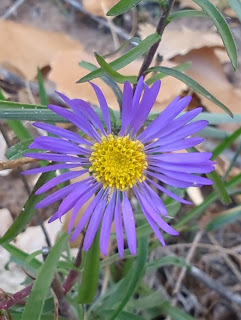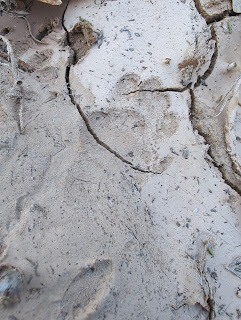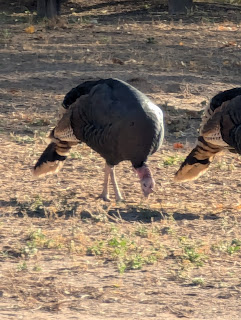"Pay heed to the tales of old wives. It may well be that they alone keep in memory what it was once needful for the wise to know." J. R. R. Tolkien
This coopers hawk was spotting trying to work out how to catch a roadrunner that would keep darting into the bushes. After 20 minutes of swooping and diving, it gave up after only catching tail feathers.
"The Road goes ever on and onDown from the door where it began.
Now far ahead the Road has gone,
And I must follow, if I can" Tolkein
The cold weather is quite bitter, but is the perfect temperature for the sandhill cranes who are visiting while the weather is to their taste. They travel north in the summer, following the cold as far north as Russia.
Plants do not travel. The cold spell this year started earlier than most trees were ready for. Leaves falling from a tree are actually following a very complex process called abscission. A special layer of cells has to be formed by the influence of hormones which then are broken down by enzymes. This year the leaves were still on the tree when the snow came, breaking branches from the extra weight.
Plants do not travel. The cold spell this year started earlier than most trees were ready for. Leaves falling from a tree are actually following a very complex process called abscission. A special layer of cells has to be formed by the influence of hormones which then are broken down by enzymes. This year the leaves were still on the tree when the snow came, breaking branches from the extra weight.
The enzymes cellulase and polygalacturonase were missing this year, causing marcescence.
"War must be, while we defend our lives against a destroyer who would devour all" Tolkein
"War must be, while we defend our lives against a destroyer who would devour all" Tolkein
This is some kind of mint species, often become a weed because it can persist growing during a mild winter. It is likely catnip. This plant is not actually planted because it gets cats "high" (it only works on about two thirds of felines) but because it is shown to repel mosquitos.
The top of the catnip plants show the flowers after they have died back, their function fulfilled. The seeds remain and are shaken out by natural processes like wind blowing, or rain. The are quite prolific and often can't be eradicated once planted.
"but still there is much that is fair, and though in all lands love is now mingled with grief, it grows perhaps the greater.” Tolkein
"but still there is much that is fair, and though in all lands love is now mingled with grief, it grows perhaps the greater.” Tolkein
Asters are a very hardy flower and persist long after other species have died back from the cold. There are very few typical pollinators around now, but there are still some. Especially beetles and flies.
“He told them tales of bees and flowers, the ways of trees, and the strange creatures of the Forest, about the evil things and the good things, things friendly and things unfriendly, cruel things and kind things, and secrets hidden under brambles.” Tolkein
Mammals are very effective at staying ot of sight of humans. This is likely a raccoon track because of the large, well spread out, long toes. These animals spend much of the night time following mud tracks looking for anything edible.
The size of this footprint suggests it is a squirrel. The plantigrade (heel print) print shows that it is a rodent of some sort, not an animal built for running like a dog or cat.
cats tend to have very circular paws shapes, unlike the more oval pattern of the canids. They have a much softer footfall, so they often are much less likely to leave a pattern in hard surfaces, especially as they don't have extended claw marks to help did into the ground.
Rubber rabbitbush is a very common plant throughout the southwest. It is ignored mostly because it is not preferred by livestock. Apparently it has a high concentration of rubber. It is also an aster species, producing flowers late into the winter season. It is heavily browsed when other food is scarce, one of the crucial "starvation foods" that so many wild animals rely on as a reserve.
"
The one small garden of a free gardener was all his need and due, not a garden swollen to a realm; his own hands to use, not the hands of others to command." Tolkein
This is probably Mentzelia involucrata. The blazing stars are of interest because of their pretty flowers rather than any utility they have to humans. Still, the flower industry in the US is estimated this year to be worth 52 billion dollars. These flowers are usually found near to a water source like a spring, or a arroyo in the hills.
"I am wounded with knife, sting, and tooth, and a long burden. Where shall I find rest?'"TolkeinKingcup cactus are fascinating because they are not known for their beautiful flowers, but they should be. They are nectar powerhouses and produce occasional bright, very showy flowers. The rest of the time they just look like a prickly pebble, of course.
Silvery lupine is a shrub with beautiful flowers that is native to the western US. It is a member of the pea family, and grows in poor soils which it supplements with nitrogen produced in its own roots.
one of the many ipomopsis species this is called many flowered. It is a native of north america and is in a family of plants called skyrockets. They are very attractive to hummingbirds and bees.
One thing gardeners prize as much as a beautiful flower is endless, diversonary variety. This is another species of ipomopsis known as flaxflowered because of similiarity to flax flowers.
"But in the end, it’s only a passing thing… this shadow. Even darkness must pass."" Tolkein.
Silvery lupine is a shrub with beautiful flowers that is native to the western US. It is a member of the pea family, and grows in poor soils which it supplements with nitrogen produced in its own roots.
one of the many ipomopsis species this is called many flowered. It is a native of north america and is in a family of plants called skyrockets. They are very attractive to hummingbirds and bees.
One thing gardeners prize as much as a beautiful flower is endless, diversonary variety. This is another species of ipomopsis known as flaxflowered because of similiarity to flax flowers.
"But in the end, it’s only a passing thing… this shadow. Even darkness must pass."" Tolkein.
Like many others, I suspect that the public's scapegoating of coyotes is a symptoms of a much deeper malady of negative self reflection. Putting the blame of our own ills toward pet ownership and fear of our place in the natural world into a convenient guilty party. The problem is that the scat of a coytoe in Corrales is almost excusively vegetable matter. An obligate meat eater, like a cat, produces scat like the one above, dark and oily from digested blood and fat.
Flat top broomrape is one of the many maligned parasitic species. This plant seed lies dormant in the soil and forms when the molecules of a suitable plant species is detected. Some bloomrapes are specific to one plant, but others can link with and subsume nutrients from many species of plant root. In a monoculture like farming these parasites can completely destroy a crop, just like a small enclosed space like an aquarium, or a chicken coop can foster viruses, or fungal growth, or bacteria.
The unique conditions in the Corrales bosque seems to encourage visitors, but not many of those stick around. There are many species of raptors who come and go as they travel along the Rio Grande river. The cooper's hawks seem to be the most at home, having learnt long ago that bird feeders feed them as well.
The large herons are often around when the water levels in the clear ditch are rising or falling. They seem to be very good at predicting when things are about to change.
The mallards feed well at carrie tingley ponds on white bread from people who like ffeding ducks. They also feed in the ditches of Corrales, but here they aeem more intent in feeding for the purpose of bonding, or just because dabbling is what ducks like to do.
"Therefore with my eyes you shall see, and with my ears you shall hear, and nothing shall be hidden from you." J.R.R. Tolkien
"Some of my kin look just like trees now, and need something great to rouse them; and they speak only in whispers." Tolkien
In evolutionary terms, both humans and fungi belong to a larger group called Opisthokonta, we both have a 12-amino-acid insertion in the translation elongation factor 1α gene. This shared characteristic indicates a common ancestor, placing fungi and animals closer together on the tree of life than either is to plants. This mushroom is the reproduce apparatus of a distant relative, who is feeding on the trunk of a very distant relative.
This mushroom is called the Destructive Pholiota. It is not edible and prefers cottonwood trees. It is not actually a Pholiota species of mushroom. It is not often found this far south."To go there is to destroy the magic, unless new unattainable vistas are again revealed" Tolkien.
I am still trying to find the identy of these mystery seeds, found out in the hills on BLM land in New Mexico. I doubt they were transported there by people but its possible. It is odd that no matter how long a person can study something like nature in their own backyard, them more questions arise, than answers.
A common weed in the Corrales bosque is one of these amaranth species. This is doubly odd as the amaranth has been cultivated by people for about 8,000 years, just not in the last few generations. Humans actively encouage its evolution into a rapid growing, hardy species that can take heavy mowing and thrives in marginal growing conditions where there is no competition.The unique conditions in the Corrales bosque seems to encourage visitors, but not many of those stick around. There are many species of raptors who come and go as they travel along the Rio Grande river. The cooper's hawks seem to be the most at home, having learnt long ago that bird feeders feed them as well.
The large herons are often around when the water levels in the clear ditch are rising or falling. They seem to be very good at predicting when things are about to change.
The mallards feed well at carrie tingley ponds on white bread from people who like ffeding ducks. They also feed in the ditches of Corrales, but here they aeem more intent in feeding for the purpose of bonding, or just because dabbling is what ducks like to do.
"Therefore with my eyes you shall see, and with my ears you shall hear, and nothing shall be hidden from you." J.R.R. Tolkien
The dry flowers often hide all sorts of insects that seem to recover on warm days in the winter . This is a soldier beetle. They have forewings that are leathery, instead of the more common tough elytra covering of a typical beetle.
It is quite unusual to still be seeing ants outside. This is a pretty common species the bicolored carpenter ants. In fact, they are often sold as an easy to grow colony and know for having docile natures. Their diet and habits are quite varied but they live in the soil and hibernate for 2-3 months of the year in the coldest part of the year.
grown fat with endless brooding on her feasts, weaving webs of shadow; for all living things were her food, and her vomit darkness. J.R.R. Tolkien
Dry sunny days in winter seem to encourage some of the hunting spiders to come out and stalk about a little. This is a Western Parson Spider, and is nowhere near as scary as a spider's reputation would lead us to believe.
This spider is also in the group Gnaphosidae, like the Western Parson Spider above, but it is very difference in appearance. Spiders are hugely diverse and are not even classified as insects, which are in a different subphyla; HexapodaIt is quite unusual to still be seeing ants outside. This is a pretty common species the bicolored carpenter ants. In fact, they are often sold as an easy to grow colony and know for having docile natures. Their diet and habits are quite varied but they live in the soil and hibernate for 2-3 months of the year in the coldest part of the year.
""It is not our part to master all the tides of the world, but to do what is in us for the succour of those years wherein we are set, uprooting the evil in the fields that we know, so that those who live after may have clean earth to till. What weather they shall have is not ours to rule."" J.R.R Tolkien
These ants are one of the types that farm insects that produce honeydew secretions. Not only aphids, but also scale insects and whitefly. These ants also collect fallen seeds, like cottonwood and elm seeds. In the summer they are quick to scavenger fallen insects, such as grasshoppers. Their wide range of behaviors means they have a wide range of habitiats they can thrive in.
Many plants spread their seeds during the cold winter months. The cattails appear to use their fluff to make it difficult for birds to cllect the tiny seeds. The downside to this is that the seeds do not have much time to survive poor conditions, but this does not seem to be a problem for them most of the time. The vast number of seeds produced (220,000) means that usually some plants will spread as long as conditions are favorable.
The Corrales bosque is a very managed environment, with land built up, river courses stabilized and vast amounts of soil shifted about to control the lanscape. This is not always easy to see. The protective levees reduce property damage and are pretty solid in this part of New Mexico. Of course, the last big flood event in Corrales was only 10 years ago, at the end of July, 2013. I t is illuminating to read the reports from back then and how the journalists talked about the "post dam" era after Cochiti dam had been built. I reflect on this as the El Vado dam repairs are pushed back to at least 2026. The new step off dam feature at the Corrales siphon is likely to have unpredictable effects as well.
Uncertainty can cause predictably confused results. As part of the issues seen in Albuquerque's south valley's notoriously inadequate earthern levee, increased attention has been paid to the levee protecting Corrales from the kinds of flooding seen 1868, 1874, 1904, 1929, 1941, 1962, 1975, 1988, 1991, 1999. Even though the risk of flooding in Corrales is deemed slight, it includes 43% of Corrales properties as of the current flood maps. As usual, this is somehow translated into removing more trees. The link is well argued, but still turns out to be a bit tenous.
"It is not our part to master all the tides of the world, but to do what is in us for the succour of those years wherein we are set" J. R. R TolkienCorrales is a difficult place to understand when looking under the hood. A place that appears to be wild and carefree can also be seen in the context of different societies riven from within and threatened from without by divisions and fracas. It is nonethe less held together by a band of shared interest. How we use this land is clearly seen differently by differnt groups. We are still the stewards of our place of residence, whether we are directly involved, or not.
It may not be easy to figure out what is right, but at a minimum, ask yourself who is responsible for picking up the dog poop bag shown in this picture?




























































